An official website of the United States government
 United States Department of Labor
United States Department of Labor
Manage, improve, and protect natural resources to maximize their use without damaging the environment. May conduct soil surveys and develop plans to eliminate soil erosion or to protect rangelands. May instruct farmers, agricultural production managers, or ranchers in best ways to use crop rotation, contour plowing, or terracing to conserve soil and water; in the number and kind of livestock and forage plants best suited to particular ranges; and in range and farm improvements, such as fencing and reservoirs for stock watering. Excludes “Zoologists and Wildlife Biologists” (19-1023) and “Foresters” (19-1032).
Employment estimate and mean wage estimates for this occupation:
| Employment (1) | Employment RSE (3) |
Mean hourly wage |
Mean annual wage (2) |
Wage RSE (3) |
|---|---|---|---|---|
| 22,070 | 1.5 % | $32.23 | $67,040 | 0.6 % |
Percentile wage estimates for this occupation:
| Percentile | 10% | 25% | 50% (Median) |
75% | 90% |
|---|---|---|---|---|---|
| Hourly Wage | $18.88 | $23.79 | $30.12 | $38.28 | $47.14 |
| Annual Wage (2) | $39,270 | $49,480 | $62,660 | $79,630 | $98,060 |
Industries with the highest published employment and wages for this occupation are provided. For a list of all industries with employment in this occupation, see the Create Customized Tables function.
Industries with the highest levels of employment in this occupation:
| Industry | Employment (1) | Percent of industry employment | Hourly mean wage | Annual mean wage (2) |
|---|---|---|---|---|
| Federal Executive Branch (OES Designation) | 6,290 | 0.31 | $38.28 | $79,610 |
| Local Government, excluding schools and hospitals (OES Designation) | 5,010 | 0.09 | $27.84 | $57,900 |
| State Government, excluding schools and hospitals (OES Designation) | 4,960 | 0.23 | $28.12 | $58,480 |
| Social Advocacy Organizations | 2,980 | 1.34 | $31.87 | $66,290 |
| Colleges, Universities, and Professional Schools | 1,140 | 0.04 | $35.14 | $73,090 |
Industries with the highest concentration of employment in this occupation:
| Industry | Employment (1) | Percent of industry employment | Hourly mean wage | Annual mean wage (2) |
|---|---|---|---|---|
| Social Advocacy Organizations | 2,980 | 1.34 | $31.87 | $66,290 |
| Federal Executive Branch (OES Designation) | 6,290 | 0.31 | $38.28 | $79,610 |
| State Government, excluding schools and hospitals (OES Designation) | 4,960 | 0.23 | $28.12 | $58,480 |
| Museums, Historical Sites, and Similar Institutions | 190 | 0.11 | $27.04 | $56,240 |
| Local Government, excluding schools and hospitals (OES Designation) | 5,010 | 0.09 | $27.84 | $57,900 |
Top paying industries for this occupation:
| Industry | Employment (1) | Percent of industry employment | Hourly mean wage | Annual mean wage (2) |
|---|---|---|---|---|
| Business, Professional, Labor, Political, and Similar Organizations | 60 | 0.01 | $48.33 | $100,520 |
| Scientific Research and Development Services | 220 | 0.03 | $42.33 | $88,050 |
| Grantmaking and Giving Services | 30 | 0.02 | $39.03 | $81,180 |
| Federal Executive Branch (OES Designation) | 6,290 | 0.31 | $38.28 | $79,610 |
| Colleges, Universities, and Professional Schools | 1,140 | 0.04 | $35.14 | $73,090 |
States and areas with the highest published employment, location quotients, and wages for this occupation are provided. For a list of all areas with employment in this occupation, see the Create Customized Tables function.
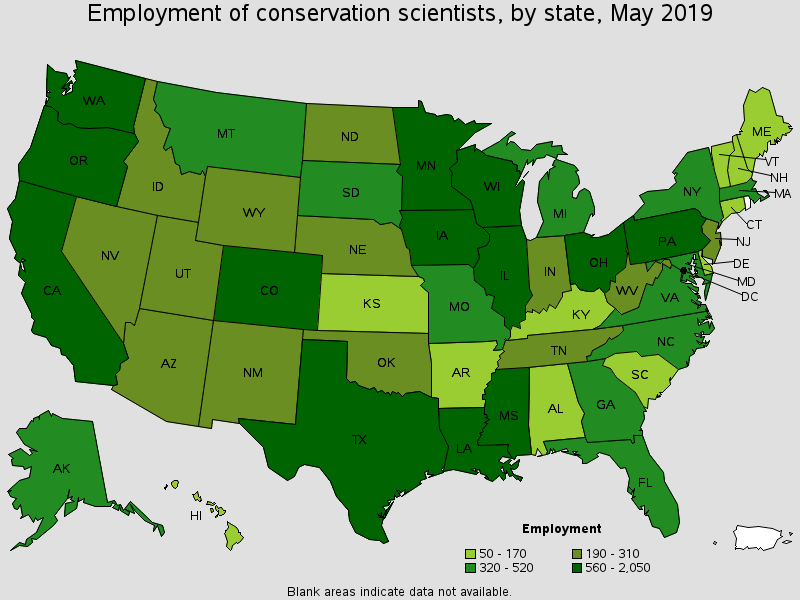
States with the highest employment level in this occupation:
| State | Employment (1) | Employment per thousand jobs | Location quotient (9) | Hourly mean wage | Annual mean wage (2) |
|---|---|---|---|---|---|
| Texas | 2,050 | 0.16 | 1.10 | $28.69 | $59,680 |
| California | 1,760 | 0.10 | 0.67 | $38.71 | $80,510 |
| Colorado | 1,300 | 0.48 | 3.22 | $35.45 | $73,740 |
| Washington | 1,020 | 0.31 | 2.04 | $31.28 | $65,070 |
| Mississippi | 840 | 0.75 | 4.96 | $26.42 | $54,950 |
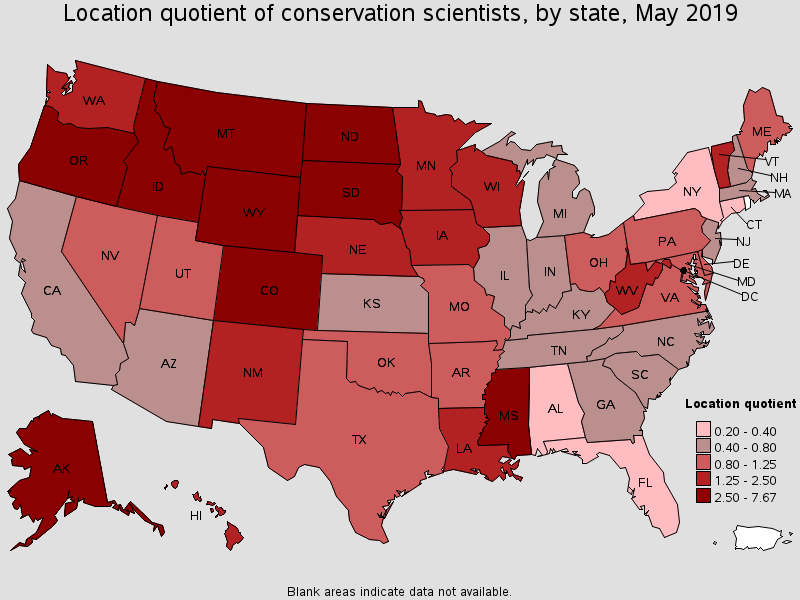
States with the highest concentration of jobs and location quotients in this occupation:
| State | Employment (1) | Employment per thousand jobs | Location quotient (9) | Hourly mean wage | Annual mean wage (2) |
|---|---|---|---|---|---|
| Alaska | 370 | 1.15 | 7.67 | $35.96 | $74,800 |
| Montana | 520 | 1.12 | 7.45 | $32.25 | $67,080 |
| South Dakota | 320 | 0.76 | 5.06 | $28.59 | $59,470 |
| Mississippi | 840 | 0.75 | 4.96 | $26.42 | $54,950 |
| Wyoming | 190 | 0.71 | 4.71 | $35.79 | $74,440 |
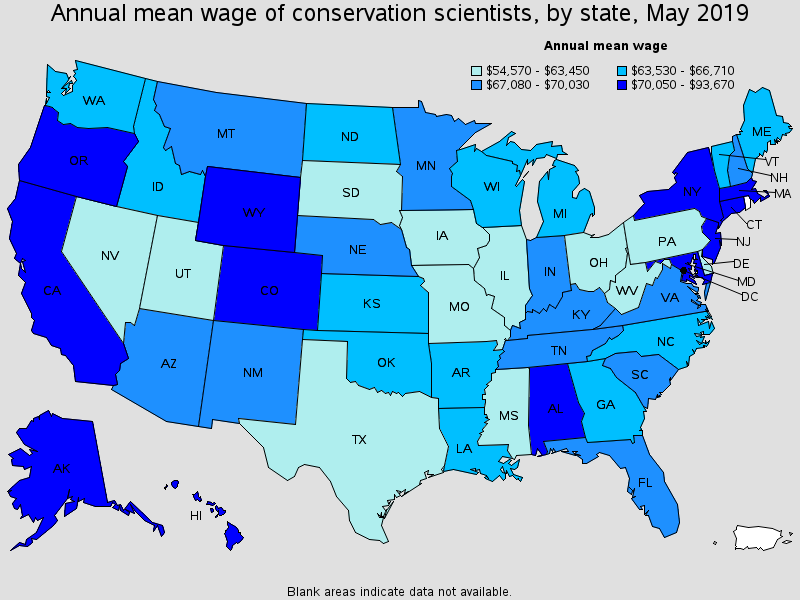
Top paying States for this occupation:
| State | Employment (1) | Employment per thousand jobs | Location quotient (9) | Hourly mean wage | Annual mean wage (2) |
|---|---|---|---|---|---|
| District of Columbia | 150 | 0.20 | 1.35 | $45.03 | $93,670 |
| Connecticut | 50 | 0.03 | 0.20 | $42.98 | $89,400 |
| New Jersey | 310 | 0.08 | 0.50 | $42.30 | $87,970 |
| Maryland | 360 | 0.13 | 0.89 | $39.48 | $82,130 |
| California | 1,760 | 0.10 | 0.67 | $38.71 | $80,510 |
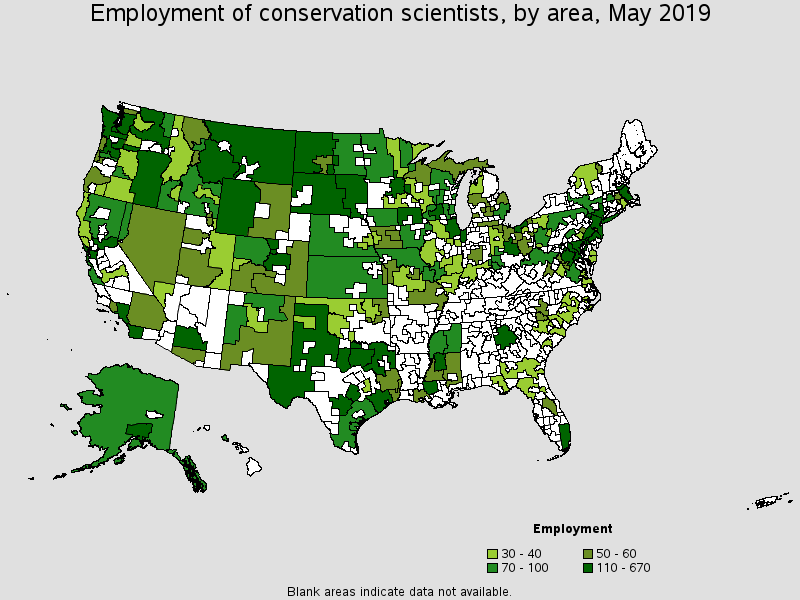
Metropolitan areas with the highest employment level in this occupation:
| Metropolitan area | Employment (1) | Employment per thousand jobs | Location quotient (9) | Hourly mean wage | Annual mean wage (2) |
|---|---|---|---|---|---|
| Fort Collins, CO | 670 | 4.04 | 26.91 | $35.01 | $72,820 |
| Jackson, MS | 520 | 1.96 | 13.03 | $25.93 | $53,920 |
| Washington-Arlington-Alexandria, DC-VA-MD-WV | 490 | 0.15 | 1.02 | $43.81 | $91,130 |
| Austin-Round Rock, TX | 440 | 0.41 | 2.71 | $27.57 | $57,340 |
| Chicago-Naperville-Elgin, IL-IN-WI | 370 | 0.08 | 0.53 | $27.92 | $58,060 |
| Baton Rouge, LA | 370 | 0.93 | 6.19 | $29.75 | $61,890 |
| New York-Newark-Jersey City, NY-NJ-PA | 360 | 0.04 | 0.25 | $41.26 | $85,810 |
| San Francisco-Oakland-Hayward, CA | 340 | 0.14 | 0.90 | $40.24 | $83,700 |
| Houston-The Woodlands-Sugar Land, TX | 290 | 0.09 | 0.63 | $25.58 | $53,200 |
| Philadelphia-Camden-Wilmington, PA-NJ-DE-MD | 280 | 0.10 | 0.65 | $26.82 | $55,780 |
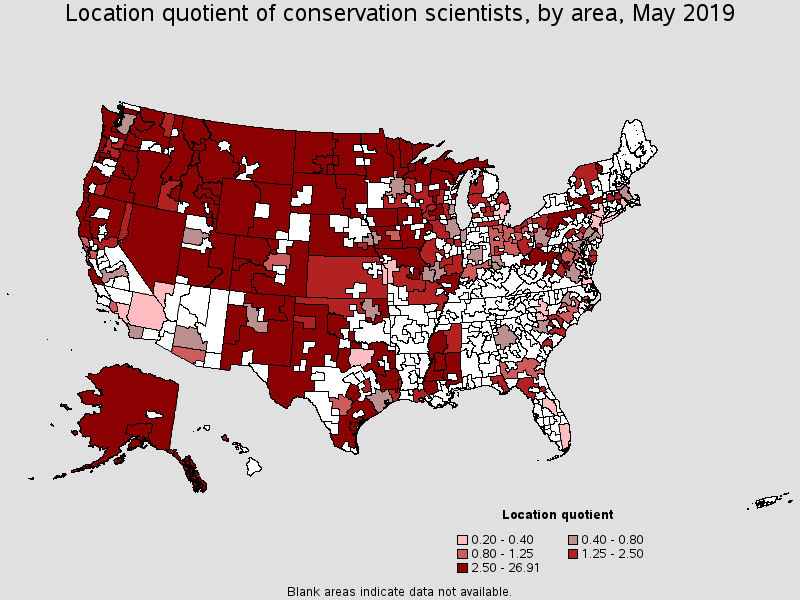
Metropolitan areas with the highest concentration of jobs and location quotients in this occupation:
| Metropolitan area | Employment (1) | Employment per thousand jobs | Location quotient (9) | Hourly mean wage | Annual mean wage (2) |
|---|---|---|---|---|---|
| Fort Collins, CO | 670 | 4.04 | 26.91 | $35.01 | $72,820 |
| Olympia-Tumwater, WA | 260 | 2.29 | 15.25 | $31.66 | $65,850 |
| Jackson, MS | 520 | 1.96 | 13.03 | $25.93 | $53,920 |
| Corvallis, OR | 60 | 1.55 | 10.29 | $44.68 | $92,940 |
| Anchorage, AK | 230 | 1.34 | 8.92 | $34.45 | $71,650 |
| Bend-Redmond, OR | 100 | 1.22 | 8.14 | $29.19 | $60,710 |
| Missoula, MT | 70 | 1.20 | 7.99 | $37.18 | $77,340 |
| Mount Vernon-Anacortes, WA | 50 | 1.06 | 7.03 | $28.01 | $58,260 |
| Baton Rouge, LA | 370 | 0.93 | 6.19 | $29.75 | $61,890 |
| Wenatchee, WA | 40 | 0.82 | 5.46 | $31.99 | $66,530 |
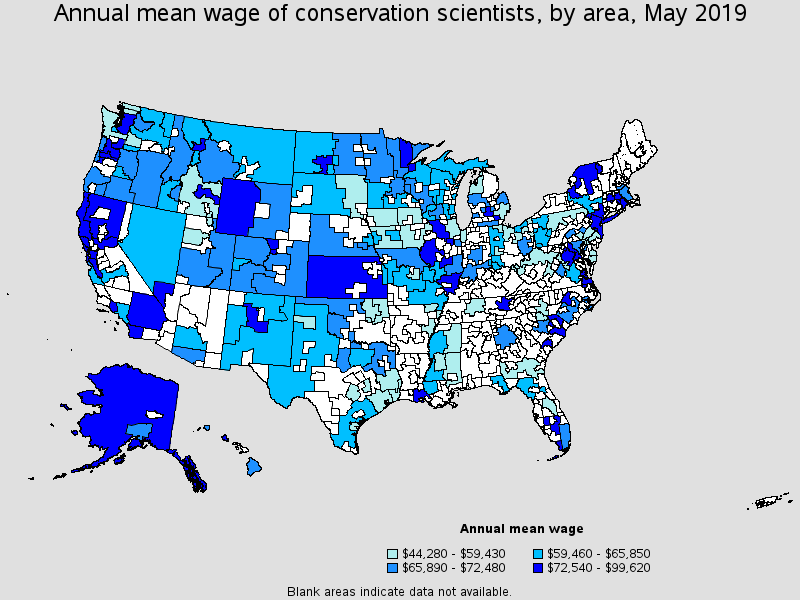
Top paying metropolitan areas for this occupation:
| Metropolitan area | Employment (1) | Employment per thousand jobs | Location quotient (9) | Hourly mean wage | Annual mean wage (2) |
|---|---|---|---|---|---|
| San Diego-Carlsbad, CA | 130 | 0.09 | 0.57 | $47.89 | $99,620 |
| Trenton, NJ | 50 | 0.23 | 1.51 | $47.65 | $99,110 |
| San Jose-Sunnyvale-Santa Clara, CA | (8) | (8) | (8) | $46.72 | $97,190 |
| Corvallis, OR | 60 | 1.55 | 10.29 | $44.68 | $92,940 |
| Boulder, CO | 150 | 0.82 | 5.48 | $44.62 | $92,810 |
| Washington-Arlington-Alexandria, DC-VA-MD-WV | 490 | 0.15 | 1.02 | $43.81 | $91,130 |
| Las Vegas-Henderson-Paradise, NV | 40 | 0.04 | 0.24 | $43.32 | $90,110 |
| Virginia Beach-Norfolk-Newport News, VA-NC | 40 | 0.06 | 0.38 | $43.08 | $89,600 |
| Albuquerque, NM | 40 | 0.11 | 0.74 | $42.85 | $89,130 |
| Sacramento--Roseville--Arden-Arcade, CA | 230 | 0.22 | 1.48 | $42.74 | $88,890 |
Nonmetropolitan areas with the highest employment in this occupation:
| Nonmetropolitan area | Employment (1) | Employment per thousand jobs | Location quotient (9) | Hourly mean wage | Annual mean wage (2) |
|---|---|---|---|---|---|
| Southwest Montana nonmetropolitan area | 250 | 1.78 | 11.82 | $31.95 | $66,460 |
| East South Dakota nonmetropolitan area | 160 | 1.18 | 7.85 | $27.13 | $56,420 |
| Eastern Washington nonmetropolitan area | 150 | 1.58 | 10.50 | $29.07 | $60,470 |
| North Texas Region of Texas nonmetropolitan area | 140 | 0.50 | 3.35 | $32.95 | $68,530 |
| West North Dakota nonmetropolitan area | 130 | 1.02 | 6.79 | $29.07 | $60,460 |
Nonmetropolitan areas with the highest concentration of jobs and location quotients in this occupation:
| Nonmetropolitan area | Employment (1) | Employment per thousand jobs | Location quotient (9) | Hourly mean wage | Annual mean wage (2) |
|---|---|---|---|---|---|
| West South Dakota nonmetropolitan area | 130 | 2.08 | 13.85 | $29.84 | $62,060 |
| East-Central Montana nonmetropolitan area | 130 | 1.93 | 12.87 | $30.32 | $63,070 |
| Southwest Montana nonmetropolitan area | 250 | 1.78 | 11.82 | $31.95 | $66,460 |
| East North Dakota nonmetropolitan area | 100 | 1.60 | 10.67 | $31.69 | $65,910 |
| Eastern Washington nonmetropolitan area | 150 | 1.58 | 10.50 | $29.07 | $60,470 |
Top paying nonmetropolitan areas for this occupation:
| Nonmetropolitan area | Employment (1) | Employment per thousand jobs | Location quotient (9) | Hourly mean wage | Annual mean wage (2) |
|---|---|---|---|---|---|
| Alaska nonmetropolitan area | 90 | 0.83 | 5.55 | $38.82 | $80,750 |
| South Florida nonmetropolitan area | (8) | (8) | (8) | $37.95 | $78,930 |
| North Coast Region of California nonmetropolitan area | 40 | 0.42 | 2.78 | $37.34 | $77,660 |
| Western Wyoming nonmetropolitan area | 110 | 1.14 | 7.56 | $37.00 | $76,960 |
| Capital/Northern New York nonmetropolitan area | 40 | 0.31 | 2.04 | $36.99 | $76,950 |
These estimates are calculated with data collected from employers in all industry sectors, all metropolitan and nonmetropolitan areas, and all states and the District of Columbia. The top employment and wage figures are provided above. The complete list is available in the downloadable XLS files.
The percentile wage estimate is the value of a wage below which a certain percent of workers fall. The median wage is the 50th percentile wage estimate--50 percent of workers earn less than the median and 50 percent of workers earn more than the median. More about percentile wages.
(1) Estimates for detailed occupations do not sum to the totals because the totals include occupations not shown separately. Estimates do not include self-employed workers.
(2) Annual wages have been calculated by multiplying the hourly mean wage by a "year-round, full-time" hours figure of 2,080 hours; for those occupations where there is not an hourly wage published, the annual wage has been directly calculated from the reported survey data.
(3) The relative standard error (RSE) is a measure of the reliability of a survey statistic. The smaller the relative standard error, the more precise the estimate.
(8) Estimate not released.
(9) The location quotient is the ratio of the area concentration of occupational employment to the national average concentration. A location quotient greater than one indicates the occupation has a higher share of employment than average, and a location quotient less than one indicates the occupation is less prevalent in the area than average.
Other OES estimates and related information:
May 2019 National Occupational Employment and Wage Estimates
May 2019 State Occupational Employment and Wage Estimates
May 2019 Metropolitan and Nonmetropolitan Area Occupational Employment and Wage Estimates
May 2019 National Industry-Specific Occupational Employment and Wage Estimates
Last Modified Date: July 6, 2020